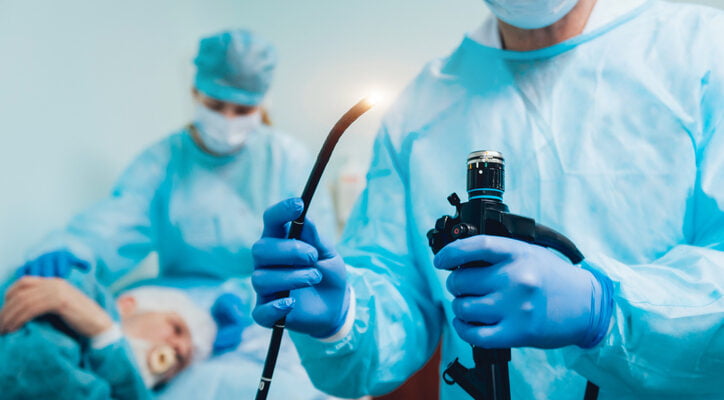As medical imaging technology advances, endoscope systems demand ever-higher image clarity, transmission stability, and cable flexibility. Traditional copper assemblies struggle with limited bandwidth, electromagnetic interference (EMI) susceptibility, and bulky form factors, making them unfit for uncompressed 8K60 video. In this article, we dive deep into cutting-edge Active Optical Cable (AOC) technology, highlighting its core benefits and practical applications in upgrading endoscope cabling. Discover how to select an ultra-slim, ultra-flexible, and naturally EMI-immune high-definition cable solution for your endoscope equipment.
1. Why 8K60 Is Becoming the New Standard in Endoscopy
1.1 Ultra-High Resolution
8K resolution (7680×4320 pixels) delivers exquisitely detailed imagery, crucial for identifying subtle anatomical features and early-stage lesions. When paired with 60 frames per second (8K60), surgeons gain smoother, more precise real-time visuals—essential for delicate procedures.
1.2 High-Speed Real-Time Transmission
Uncompressed 8K60 requires bandwidth in excess of 40 Gbps. Conventional copper cables typically cap out around 10 Gbps, leading to dropped frames, stuttering video, and compromised diagnostic confidence. AOC removes these limitations.
2. How Active Optical Cable (AOC) Works
An Active Optical Cable integrates an electrical-to-optical-to-electrical conversion module at each end. Its key components include:
Laser or High-Speed LED Transmitter: Converts incoming electrical data into optical signals.
Ultra-Fine Optical Fiber Core: Carries light pulses over long distances at extremely high data rates.
Optical Receiver (Photodetector): Reconstructs the original electrical signals from the light pulses.
Compared with copper wiring, AOC offers:
Massive Bandwidth Headroom
Fiber-optic transmission easily supports tens or hundreds of gigabits per second—ideal for 8K60, and even 10K or 12K video streams.
Natural Immunity to EMI
Optical signals aren’t influenced by electromagnetic fields, eliminating the need for heavy shielding and ensuring signal purity in electrically noisy operating rooms.
Electrical Isolation
The complete galvanic isolation between transmitter and receiver prevents ground-loop currents and leakage risks, safeguarding both patient and clinician.
3. Ultra-Slim & Ultra-Flexible: Solving Space and Routing Challenges
Endoscope systems demand the slimmest, most flexible cables possible:
Ultra-Slim Profile
AOC assemblies can be as thin as 1.8 mm in diameter, compared to 5–8 mm for equivalent copper cables. This dramatic size reduction frees up space on handpieces and carts, and improves maneuverability in tight surgical fields.
Exceptional Flexibility
Using multi-strand bare optical fibers within a pliable jacket, AOC cables boast bend radii down to 10 mm without signal degradation or core damage. Repeated flexing over thousands of cycles—common in endoscope procedures—remains perfectly reliable.
4. Copper vs. Active Optical Cable: A Side-by-Side Comparison
|
Feature |
Traditional Copper Cable |
Active Optical Cable (AOC) |
|
Maximum Bandwidth |
≤ 10 Gbps |
≥ 40 Gbps (supports 8K60+) |
|
EMI Resistance |
Requires multi-layer shielding; still vulnerable |
Intrinsic immunity; no shielding needed |
|
Cable Diameter |
5–8 mm |
1.8–2.5 mm |
|
Minimum Bend Radius |
≥ 30 mm |
≥ 10 mm |
|
Weight |
Relatively heavy |
Significantly lighter |
|
Electrical Isolation |
None |
Full galvanic isolation |
5. Real-World Applications in Endoscope Systems
Long-Reach, Lossless Transmission
In large operating suites or multi-room setups, AOC delivers uncompressed HD signals over 100 m without repeaters—far beyond copper’s practical limit of 10–15 m.
Instant High-Definition Output
Plug directly into HDMI 2.1 or DisplayPort 2.0 host devices for uncompressed 8K60 streams. No frame buffering or compression artifacts—just crystal-clear, real-time imagery.
Compact, Modular Design
Our AOC conversion module measures just 20 × 12 × 5 mm, making it easy to embed in endoscope handles, camera heads, or external adapter boxes for customized system integration.
6. How to Choose and Implement AOC for Your Endoscope
Step 1: Determine Bandwidth Needs
Assess your system’s maximum resolution and frame rate (e.g., 8K60, 4K120) and select an AOC module rated for 40 Gbps, 80 Gbps, or 120 Gbps accordingly.
Step 2: Verify Interface Compatibility
Choose cables and modules that support HDMI 2.1, DisplayPort 2.0, or SDI—whichever matches your endoscope camera head and processor.
Step 3: Custom Length & Jacket Options
Specify lengths from 5 m up to 100 m, and choose jacket materials such as PVC, LSZH (Low-Smoke Zero-Halogen), or medical-grade silicone for sterilization compatibility.
Step 4: Rigorous Reliability Testing
Our cables undergo MIL-STD-810 validation, RoHS compliance checks, CE and FDA certifications, plus over 10,000 flex cycles to guarantee flawless clinical performance.
7. Conclusion: Ushering in a New Era of Endoscopic Imaging
By leveraging 8K60 ultra-HD transmission and Active Optical Cable technology, endoscope manufacturers can finally overcome copper’s limitations. Ultra-slim, ultra-flexible cabling with innate EMI immunity and full electrical isolation ensures safer, more reliable medical imaging. Empower your surgical teams with the clarity and confidence they deserve—focus on patient care, not signal integrity.
Contact us now to request endoscope-grade AOC samples and technical support. Let’s innovate the future of medical imaging together!
Smartavlink Contact Information
Email: info@smartavlink.com
Website: www.smartavlink.com

